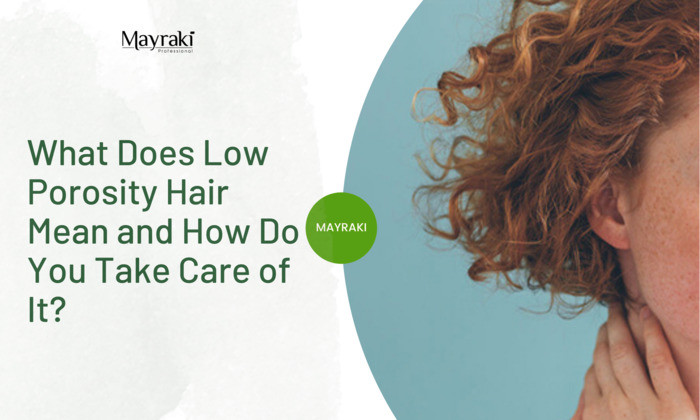What Does Low Porosity Hair Mean and How Do You Take Care of It?
Aug 22, 2022 | By Maria Eliza Pineda

Hair porosity plays an important part in your hair care routine. It pretty much decides what products you should be using and what you should be doing with your hair. However, not a lot of people realize this or even know what their hair porosity is.
What exactly is hair porosity? It’s basically the structural integrity and texture of your hair. You can have low or high porosity hair that determines how your hair absorbs and retains moisture and nourishment. Your hair porosity determines what kind of hair care routine you should have based on the way it absorbs the product. If you lack or overload on something, it can mess with the health of your hair. So, knowing your hair porosity is incredibly important when it comes to choosing the right products and practices.
How to Tell If You Have Low Porosity Hair
Your Hair History
Your hair history is one of the most accurate ways you can find out if you have low or high porosity hair. A lot of people spread around tricks like the “float” test but it’s not as reliable as knowing your hair’s history and using inductive reasoning based on your hair’s history. The formula goes more damage = higher porosity.
With that in mind, ask yourself these questions: have you colored or bleached your hair? Have you had processes like perms or relaxers? Do you heat style your hair regularly? If you’ve never done any of these things or have rarely done them, you will probably have low porosity hair. Less damage means fewer holes in your hair’s cuticle and lower porosity.
Your Hair Texture
Of course, hair porosity isn’t just determined by hair history because some people might have high porosity hair naturally. Another way you can tell is just by feeling your hair texture. Take a strand between your thumb and forefinger and just run it down to feel your hair’s thickness. If you feel that it is thinner but rougher, that means the cuticle is thin and porous and you have high porosity hair. If you feel the strand is thick and smooth, you have a good layer of cuticle and low porosity hair.
Moisture Absorption
Last but not least, the reason the float test became a thing, the moisture absorption test. High porosity hair absorbs moisture very quickly while low porosity hair is the exact opposite. This led people to believe that if the hair floats (does not absorb water and sink), then they have low porosity hair, and if the hair sinks (absorbs water easily and will sink quickly), then they have high porosity hair. Makes sense, right? Kind of but there is an even better, more accurate, and easier way to tell.
The float test will not be accurate because oils and other factors attached to the hair can cause it to float. An easier way to tell is just to take a shower without any type of product in your hair. If the hair gets wet easily, that means you have high porosity hair. If you have to stand beneath the shower for a long time before your hair gets wet, that probably means you have low porosity hair.
Another way to tell is how long it takes you to dry your hair. Low porosity hair has a difficult time absorbing moisture because the cuticle isn’t porous but this also means that it retains that moisture more effectively. If it takes ages to dry your hair, it means you have low porosity hair. If your hair dries easier, you have high porosity hair.
How to Take Care of Low Porosity Hair
The good news is that low porosity hair is the best kind of hair that you can have! It means that your locks are not damaged and as healthy as can be. The only thing that you should be doing is keeping it that way. You can do that by protecting your hair from damage you experience in your daily life so you can keep your hair’s keratin cuticle nice and tightly sealed.
Deep Condition
As mentioned before, low porosity hair has a hard time absorbing moisture but it also retains a lot of it. But that doesn’t mean that you can’t deep condition once in a while to really get that moisture in there. Do a deep conditioning treatment every few months to renew the moisture in your hair. Just don’t do it too often to prevent oiliness and moisture overload!
Leave-Ins
A leave-in is a great product to get your hair to slowly absorb moisture throughout the day and keep your hair soft and smooth. Applying a tiny amount of leave-in conditioner after wash day will help your hair get more nourishment and protect it from damage as you go about your daily life.
Heat Protectant
Heat is one of the most common and unavoidable types of damage your hair can get. Even if you don’t style your hair, even just taking a walk out in the sun can cause some heat damage. Make sure to always put a heat protectant on before you go out. And if you do choose to heat-style your hair, this will ensure that your hair gets the least amount of damage from the high-heat tools.
Cleansing and Antioxidant Treatments
Another common cause of damage that’s pretty much unavoidable is pollution or toxins. This is just in the air all around us whether you’re outside or inside your house, the air is going to have some dust, bacteria, and toxins. These free radicals do cause some damage to the hair and it definitely doesn’t feel nice when it accumulates in your roots. Always do a deep cleansing and antioxidant treatment to get rid of all that buildup.




